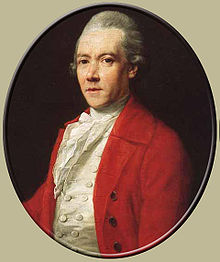Philip Livingston
Philip Livingston (born January 15, 1716 in Albany , New York Province, † June 12, 1778 in York , Pennsylvania ) was a trader, politician and signatory of the United States' Declaration of Independence .
Life
He was born into the prominent Livingston family. His grandfather, who immigrated to New York and controlled a large estate called Gut Livingston (Livingston Manor), was known as Robert, 1st Lord of the Manor . His father Philip Livingston was the second Lord of the Manor . This Philip was his fourth son, so he couldn't inherit. The wife of the second Lord of Manor was a daughter of the Mayor of Albany, New York.
Livingston attended Yale College and graduated in 1737. Then he settled in New York City and pursued a commercial career. He became known as a trader and was elected to the city council in 1754. He was confirmed in office every year until 1763. In 1754 he was sent as a delegate to the Albany Congress. There he joined the delegates from various other colonies to negotiate with the Indians and to discuss general plans in connection with the French and Indian wars. They also developed a plan for a union of the colonies, which was rejected by King George II .
Livingston became an active supporter of the formation and equipment of troops for the war and was elected to the Colony's House of Representatives in 1759. He held the office until 1769 and served as Speaker of the House of Representatives in 1768. In October 1765, he attended the Stamp Act Congress, which produced the first formal protest to the Crown, a prelude to the American independence movement . Livingston strongly joined the radical bloc in Congress. He joined the New York Correspondence Committee to continue communication with the leaders of the other colonies.
When New York established a rebel government in 1775, he was President of the Provincial Parliament. They also voted him one of the delegates for the Continental Congress that year . In Congress he strongly supported the separation from Great Britain and signed the Declaration of Independence of the United States in 1776 with other delegates.
After the New York Constitution was adopted, he was elected to the State Senate in 1777 while continuing to serve on the Continental Congress. He died suddenly while attending the sixth session of Congress in York, Pennsylvania , and is buried in the Lookout Hill Cemetery. Livingston was a Presbyterian , a Freemason, and one of the earliest supporters of Kings College, now Columbia University .
His brother was Governor William Livingston ; his cousin Robert R. Livingston was a US Congressman and Chancellor. His wife Christina Ten Broeck was a great-granddaughter of the Mayor of Albany, New York . One of his daughters, Catherina, married Stephen Van Rensselaer; their son Stephen Van Rensselaer III married Margarita Schuyler - a daughter of Philip Schuyler .
Web links
- Philip Livingston in the Biographical Directory of the United States Congress (English)
- Philip Livingston in the database of Find a Grave (English)
Individual evidence
- ↑ Peter Van Burgh
- ↑ Dirck Wesselse Ten Broeck ( page no longer available , search in web archives ) Info: The link was automatically marked as defective. Please check the link according to the instructions and then remove this notice.
| personal data | |
|---|---|
| SURNAME | Livingston, Philip |
| BRIEF DESCRIPTION | Merchants and Politicians in the United States |
| DATE OF BIRTH | January 15, 1716 |
| PLACE OF BIRTH | Albany , New York, United Kingdom |
| DATE OF DEATH | June 12, 1778 |
| Place of death | York , Pennsylvania, United States |

